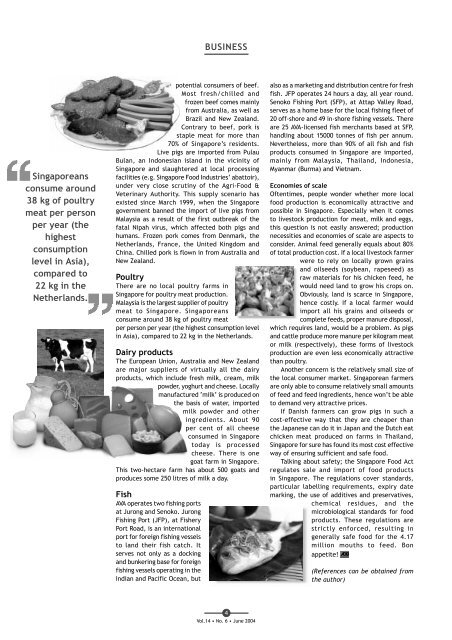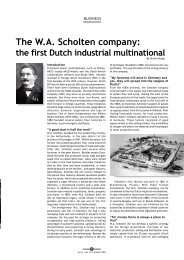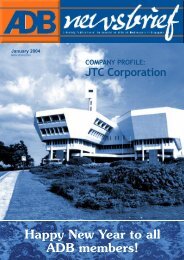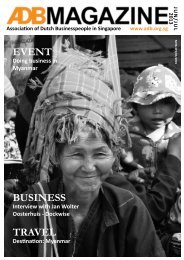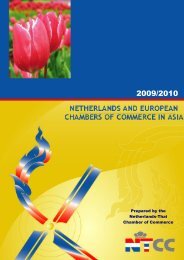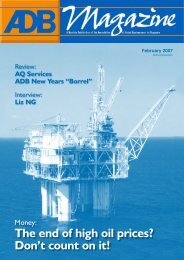June 2004 - Association of Dutch Businessmen
June 2004 - Association of Dutch Businessmen
June 2004 - Association of Dutch Businessmen
You also want an ePaper? Increase the reach of your titles
YUMPU automatically turns print PDFs into web optimized ePapers that Google loves.
BUSINESS<br />
Singaporeans<br />
consume around<br />
38 kg <strong>of</strong> poultry<br />
meat per person<br />
per year (the<br />
highest<br />
consumption<br />
level in Asia),<br />
compared to<br />
22 kg in the<br />
Netherlands.<br />
potential consumers <strong>of</strong> beef.<br />
Most fresh/chilled and<br />
frozen beef comes mainly<br />
from Australia, as well as<br />
Brazil and New Zealand.<br />
Contrary to beef, pork is<br />
staple meat for more than<br />
70% <strong>of</strong> Singapore’s residents.<br />
Live pigs are imported from Pulau<br />
Bulan, an Indonesian island in the vicinity <strong>of</strong><br />
Singapore and slaughtered at local processing<br />
facilities (e.g. Singapore Food Industries’ abattoir),<br />
under very close scrutiny <strong>of</strong> the Agri-Food &<br />
Veterinary Authority. This supply scenario has<br />
existed since March 1999, when the Singapore<br />
government banned the import <strong>of</strong> live pigs from<br />
Malaysia as a result <strong>of</strong> the first outbreak <strong>of</strong> the<br />
fatal Nipah virus, which affected both pigs and<br />
humans. Frozen pork comes from Denmark, the<br />
Netherlands, France, the United Kingdom and<br />
China. Chilled pork is flown in from Australia and<br />
New Zealand.<br />
Poultry<br />
There are no local poultry farms in<br />
Singapore for poultry meat production.<br />
Malaysia is the largest supplier <strong>of</strong> poultry<br />
meat to Singapore. Singaporeans<br />
consume around 38 kg <strong>of</strong> poultry meat<br />
per person per year (the highest consumption level<br />
in Asia), compared to 22 kg in the Netherlands.<br />
Dairy products<br />
The European Union, Australia and New Zealand<br />
are major suppliers <strong>of</strong> virtually all the dairy<br />
products, which include fresh milk, cream, milk<br />
powder, yoghurt and cheese. Locally<br />
manufactured ‘milk’ is produced on<br />
the basis <strong>of</strong> water, imported<br />
milk powder and other<br />
ingredients. About 90<br />
per cent <strong>of</strong> all cheese<br />
consumed in Singapore<br />
today is processed<br />
cheese. There is one<br />
goat farm in Singapore.<br />
This two-hectare farm has about 500 goats and<br />
produces some 250 litres <strong>of</strong> milk a day.<br />
Fish<br />
AVA operates two fishing ports<br />
at Jurong and Senoko. Jurong<br />
Fishing Port (JFP), at Fishery<br />
Port Road, is an international<br />
port for foreign fishing vessels<br />
to land their fish catch. It<br />
serves not only as a docking<br />
and bunkering base for foreign<br />
fishing vessels operating in the<br />
Indian and Pacific Ocean, but<br />
also as a marketing and distribution centre for fresh<br />
fish. JFP operates 24 hours a day, all year round.<br />
Senoko Fishing Port (SFP), at Attap Valley Road,<br />
serves as a home base for the local fishing fleet <strong>of</strong><br />
20 <strong>of</strong>f-shore and 49 in-shore fishing vessels. There<br />
are 25 AVA-licensed fish merchants based at SFP,<br />
handling about 15000 tonnes <strong>of</strong> fish per annum.<br />
Nevertheless, more than 90% <strong>of</strong> all fish and fish<br />
products consumed in Singapore are imported,<br />
mainly from Malaysia, Thailand, Indonesia,<br />
Myanmar (Burma) and Vietnam.<br />
Economies <strong>of</strong> scale<br />
Oftentimes, people wonder whether more local<br />
food production is economically attractive and<br />
possible in Singapore. Especially when it comes<br />
to livestock production for meat, milk and eggs,<br />
this question is not easily answered; production<br />
necessities and economies <strong>of</strong> scale are aspects to<br />
consider. Animal feed generally equals about 80%<br />
<strong>of</strong> total production cost. If a local livestock farmer<br />
were to rely on locally grown grains<br />
and oilseeds (soybean, rapeseed) as<br />
raw materials for his chicken feed, he<br />
would need land to grow his crops on.<br />
Obviously, land is scarce in Singapore,<br />
hence costly. If a local farmer would<br />
import all his grains and oilseeds or<br />
complete feeds, proper manure disposal,<br />
which requires land, would be a problem. As pigs<br />
and cattle produce more manure per kilogram meat<br />
or milk (respectively), these forms <strong>of</strong> livestock<br />
production are even less economically attractive<br />
than poultry.<br />
Another concern is the relatively small size <strong>of</strong><br />
the local consumer market. Singaporean farmers<br />
are only able to consume relatively small amounts<br />
<strong>of</strong> feed and feed ingredients, hence won’t be able<br />
to demand very attractive prices.<br />
If Danish farmers can grow pigs in such a<br />
cost-effective way that they are cheaper than<br />
the Japanese can do it in Japan and the <strong>Dutch</strong> eat<br />
chicken meat produced on farms in Thailand,<br />
Singapore for sure has found its most cost effective<br />
way <strong>of</strong> ensuring sufficient and safe food.<br />
Talking about safety; the Singapore Food Act<br />
regulates sale and import <strong>of</strong> food products<br />
in Singapore. The regulations cover standards,<br />
particular labelling requirements, expiry date<br />
marking, the use <strong>of</strong> additives and preservatives,<br />
chemical residues, and the<br />
microbiological standards for food<br />
products. These regulations are<br />
strictly enforced, resulting in<br />
generally safe food for the 4.17<br />
million mouths to feed. Bon<br />
appetite!<br />
(References can be obtained from<br />
the author)<br />
4<br />
Vol.14 • No. 6 • <strong>June</strong> <strong>2004</strong>


